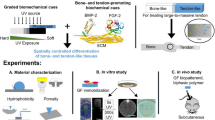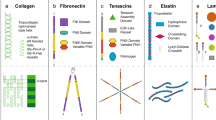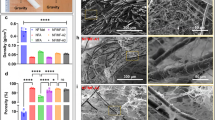Abstract
Successful engineering of load-bearing tissues requires recapitulation of their complex mechanical functions. Given the intimate relationship between function and form, biomimetic materials that replicate anatomic form are of great interest for tissue engineering applications. However, for complex tissues such as the annulus fibrosus, scaffolds have failed to capture their multi-scale structural hierarchy. Consequently, engineered tissues have yet to reach functional equivalence with their native counterparts. Here, we present a novel strategy for annulus fibrosus tissue engineering that replicates this hierarchy with anisotropic nanofibrous laminates seeded with mesenchymal stem cells. These scaffolds directed the deposition of an organized, collagen-rich extracellular matrix that mimicked the angle-ply, multi-lamellar architecture and achieved mechanical parity with native tissue after 10 weeks of in vitro culture. Furthermore, we identified a novel role for inter-lamellar shearing in reinforcing the tensile response of biologic laminates, a mechanism that has not previously been considered for these tissues.
This is a preview of subscription content, access via your institution
Access options
Subscribe to this journal
Receive 12 print issues and online access
$259.00 per year
only $21.58 per issue
Buy this article
- Purchase on Springer Link
- Instant access to full article PDF
Prices may be subject to local taxes which are calculated during checkout





Similar content being viewed by others
References
Cassidy, J. J., Hiltner, A. & Baer, E. Hierarchical structure of the intervertebral disc. Connect. Tissue Res. 23, 75–88 (1989).
Elliott, D. M. & Setton, L. A. Anisotropic and inhomogeneous tensile behavior of the human anulus fibrosus: Experimental measurement and material model predictions. J. Biomech. Eng. 123, 256–263 (2001).
Hukins, D. W. Tissue engineering: A live disc. Nature Mater. 4, 881–882 (2005).
Kandel, R. A., Roberts, S. & Urban, J. Tissue engineering and the intervertebral disc: The challenges. Eur. Spine J. 17, S480–S491 (2008).
Place, E. S., George, J. H., Williams, C. K. & Stevens, M. M. Synthetic polymer scaffolds for tissue engineering. Chem. Soc. Rev. 38, 1139–1151 (2009).
Mauck, R. L. et al. Engineering on the straight and narrow: The mechanics of nanofibrous assemblies for fiber-reinforced tissue regeneration. Tissue Eng. B 15, 171–193 (2009).
Chiba, K., Andersson, G. B. J., Masuda, K. & Thonar, E. J. M. A. Metabolism of the extracellular matrix formed by intervertebral disc cells cultured in alginate. Spine 22, 2885–2893 (1997).
Thonar, E., An, H. & Masuda, K. Compartmentalization of the matrix formed by nucleus pulposus and annulus fibrosus cells in alginate gel. Biochem. Soc. Trans. 30, 874–878 (2002).
Chou, A. I., Reza, A. T. & Nicoll, S. B. Distinct intervertebral disc cell populations adopt similar phenotypes in three-dimensional culture. Tissue Eng. A 14, 2079–2087 (2008).
Wan, Y. et al. Novel biodegradable poly(1,8-octanediol malate) for annulus fibrosus regeneration. Macromol. Biosci. 7, 1217–1224 (2007).
Chang, G., Kim, H. J., Kaplan, D., Vunjak-Novakovic, G. & Kandel, R. A. Porous silk scaffolds can be used for tissue engineering annulus fibrosus. Eur. Spine J. 16, 1848–1857 (2007).
Gruber, H. E., Ingram, J. A., Leslie, K., Norton, H. J. & Hanley, E. N. Jr Cell shape and gene expression in human intervertebral disc cells: In vitro tissue engineering studies. Biotech. Histochem. 78, 109–117 (2003).
Nerurkar, N. L., Mauck, R. L. & Elliott, D. M. ISSLS prize winner: Integrating theoretical and experimental methods for functional tissue engineering of the annulus fibrosus. Spine 33, 2691–2701 (2008).
Pittenger, M. F. et al. Multilineage potential of adult human mesenchymal stem cells. Science 284, 143–147 (1999).
Caplan, A. I. Mesenchymal stem cells. J. Orthop. Res. 9, 641–650 (1991).
Marchand, F. & Ahmed, A. M. Investigation of the laminate structure of lumbar disc annulus fibrosus. Spine 15, 402–410 (1990).
Li, W. J. et al. Evaluation of articular cartilage repair using biodegradable nanofibrous scaffolds in a swine model: A pilot study. J. Tissue Eng. Regen Med. 3, 1–10 (2009).
Nerurkar, N. L., Elliott, D. M. & Mauck, R. L. Mechanics of oriented electrospun nanofibrous scaffolds for annulus fibrosus tissue engineering. J. Orthop. Res. 25, 1018–1028 (2007).
Baker, B. M. & Mauck, R. L. The effect of nanofiber alignment on the maturation of engineered meniscus constructs. Biomaterials 28, 1967–1977 (2007).
Gokorsch, S., Weber, C., Wedler, T. & Czermak, P. A stimulation unit for the application of mechanical strain on tissue engineered anulus fibrosus cells: A new system to induce extracellular matrix synthesis by anulus fibrosus cells-dependent on cyclic mechanical strain. Int. J. Artif. Organs 28, 1242–1250 (2005).
Reza, A. T. & Nicoll, S. B. Hydrostatic pressure differentially regulates outer and inner annulus fibrosus cell matrix production in 3D scaffolds. Ann. Biomed. Eng. 36, 204–213 (2008).
Neidlinger-Wilke, C. et al. A three-dimensional collagen matrix as a suitable culture system for the comparison of cyclic strain and hydrostatic pressure effects on intervertebral disc cells. J. Neurosurg. Spine 2, 457–465 (2005).
Mizuno, H. et al. Biomechanical and biochemical characterization of composite tissue-engineered intervertebral discs. Biomaterials 27, 362–370 (2006).
Smith, L. J. & Fazzalari, N. L. Regional variations in the density and arrangement of elastic fibres in the anulus fibrosus of the human lumbar disc. J. Anat. 209, 359–367 (2006).
Stella, J. A. et al. Tissue-to-cellular level deformation coupling in cell micro-integrated elastomeric scaffolds. Biomaterials 29, 3228–3236 (2008).
Guerin, H. A. & Elliott, D. M. Degeneration affects the fibre reorientation of human annulus fibrosus under tensile load. J. Biomech. 39, 1410–1418 (2006).
Huang, A. H., Yeger-McKeever, M., Stein, A. & Mauck, R. L. Tensile properties of engineered cartilage formed from chondrocyte- and MSC-laden hydrogels. Osteoarthritis Cartilage 16, 1074–1082 (2008).
Shine, K. M. & Spector, M. The presence and distribution of lubricin in the caprine intervertebral disc. J. Orthop. Res. 26, 1398–1406 (2008).
Melrose, J. et al. Biglycan and fibromodulin fragmentation correlates with temporal and spatial annular remodelling in experimentally injured ovine intervertebral discs. Eur. Spine J. 16, 2193–2205 (2007).
Veres, S. P., Robertson, P. A. & Broom, N. D. ISSLS prize winner: Microstructure and mechanical disruption of the lumbar disc annulus. Part II. How the annulus fails under hydrostatic pressure. Spine 33, 2711–2720 (2008).
Michalek, A. J., Buckley, M. R., Bonassar, L. J., Cohen, I. & Iatridis, J. C. Measurement of local strains in intervertebral disc anulus fibrosus tissue under dynamic shear: Contributions of matrix fiber orientation and elastin content. J. Biomech. 10.1016/j.jbiomech.2009.06.047 (2009).
Rhodin, J. in Handbook of Physiology (ed. Berne, R.) (Waverly Press, 1980).
Maurice, D. M. The structure and transparency of the cornea. J. Physiol. 136, 263–286 (1957).
Clark, J. M. & Harryman, D. T. 2nd. Tendons, ligaments, and capsule of the rotator cuff. Gross and microscopic anatomy. J. Bone Joint Surg. Am. 74, 713–725 (1992).
Petersen, W. & Tillmann, B. Collagenous fibril texture of the human knee joint menisci. Anat. Embryol. (Berl) 197, 317–324 (1998).
Shields, K. J., Beckman, M. J., Bowlin, G. L. & Wayne, J. S. Mechanical properties and cellular proliferation of electrospun collagen type II. Tissue Eng. 10, 1510–1517 (2004).
Zhang, X., Baughman, C. B. & Kaplan, D. L. In vitro evaluation of electrospun silk fibroin scaffolds for vascular cell growth. Biomaterials 29, 2217–2227 (2008).
McManus, M. C., Boland, E. D., Simpson, D. G., Barnes, C. P. & Bowlin, G. L. Electrospun fibrinogen: Feasibility as a tissue engineering scaffold in a rat cell culture model. J. Biomed. Mater. Res. A 81, 299–309 (2007).
Baker, B. M. et al. The potential to improve cell infiltration in composite fibre-aligned electrospun scaffolds by the selective removal of sacrificial fibers. Biomaterials 29, 2348–2358 (2008).
Baker, B. M., Nerurkar, N. L., Burdick, J. A., Elliott, D. M. & Mauck, R. L. Fabrication and modeling of dynamic multi-polymer nanofibrous scaffolds. J. Biomech. Eng. 10.1115/1.3192140 (2009).
Sheth, N. P., Baker, B. M., Nathan, A. S. & Mauck, R. L. Transactions of the 53rd Annual Meeting of the Orthopaedic Research Society, San Diego, CA (American Academy of Orthopaedic Surgeons, 2007).
Mauck, R. L., Yuan, X. & Tuan, R. S. Chondrogenic differentiation and functional maturation of bovine mesenchymal stem cells in long-term agarose culture. Osteoarthritis Cartilage 14, 179–189 (2006).
Peltz, C. D., Perry, S. M., Getz, C. L. & Soslowsky, L. J. Mechanical properties of the long-head of the biceps tendon are altered in the presence of rotator cuff tears in a rat model. J. Orthop. Res. 27, 416–420 (2009).
Neuman, R. E. & Logan, M. A. The determination of hydroxyproline. J. Biol. Chem. 184, 299–306 (1950).
Thomopoulos, S., Williams, G. R., Gimbel, J. A., Favata, M. & Soslowsky, L. J. Variation of biomechanical, structural, and compositional properties along the tendon to bone insertion site. J. Orthop. Res. 21, 413–419 (2003).
Acknowledgements
The authors would like to thank J. B. Stambough for assistance with data collection. This work was financially supported by the National Institutes of Health (EB02425), the Aircast Foundation and the Penn Center for Musculoskeletal Disorders (AR050950).
Author information
Authors and Affiliations
Contributions
Experiments were conceived by N.L.N, B.M.B., D.M.E. and R.L.M. Studies on the evolving properties of parallel and opposing bilayers were executed by N.L.N and S.S., with assistance from E.E.W. on histologic analyses. Acellular tensile studies and cell-seeded lap testing studies were carried out by N.L.N. and B.M.B., respectively. The manuscript was prepared by N.L.N., D.M.E. and R.L.M.
Corresponding author
Rights and permissions
About this article
Cite this article
Nerurkar, N., Baker, B., Sen, S. et al. Nanofibrous biologic laminates replicate the form and function of the annulus fibrosus. Nature Mater 8, 986–992 (2009). https://doi.org/10.1038/nmat2558
Received:
Accepted:
Published:
Issue Date:
DOI: https://doi.org/10.1038/nmat2558
This article is cited by
-
A microstructure-based model for time-dependent mechanics of multi-layered soft tissues and its application to intervertebral disc annulus
Meccanica (2021)
-
Biomimetic angle-ply multi-lamellar scaffold for annulus fibrosus tissue engineering
Journal of Materials Science: Materials in Medicine (2020)
-
In Vitro Maturation and In Vivo Integration and Function of an Engineered Cell-Seeded Disc-like Angle Ply Structure (DAPS) for Total Disc Arthroplasty
Scientific Reports (2017)



